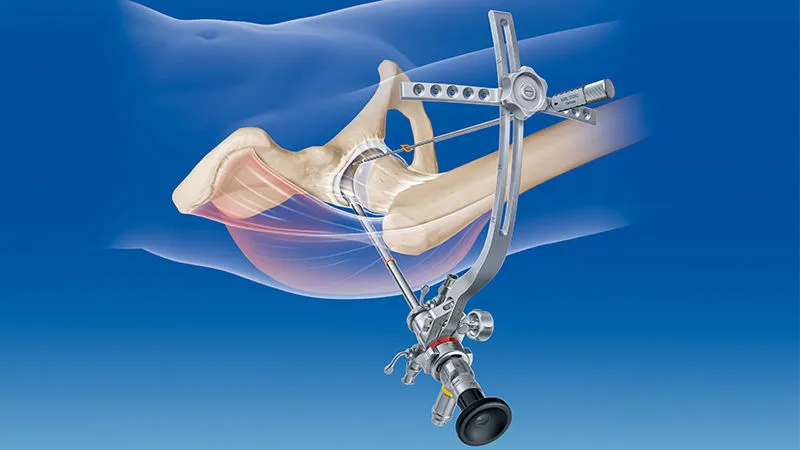Hip Arthroscopy
Hip Arthroscopy
What is Hip Arthroscopy Surgery?
Hip Arthroscopy Surgery is key hole approach to joints. Hip arthroscopy means hip joint is visualized through 4.5 mm telescope attached with a TV. It is done since many years but not as often as knee arthritis or shoulder dislocation surgery.

Anatomy of Hip Arthroscopy
The hip is a ball-and-socket joint. The socket is formed by the acetabulum, which is part of the large pelvis bone. The ball is the femoral head, which is the upper end of the femur (thighbone).
Both acetabulum and head of femur are covered by cartilage, a rubbery covering which keeps the bones away of each other.
The acetabulum is ringed by strong fibrocartilage called the labrum. The labrum forms a socket.
The joint is surrounded by many thick strong tissue bands, ligaments. They form a capsule that holds the joint together. The undersurface of the capsule is lined by a thin membrane called the synovium. It produces synovial fluid that lubricates the hip joint.
When Arthroscopic Hip Surgery Is Recommended
First line of management in any hip pathology is conservative, non-surgical management. That includes ice, NSAID medicines and physio. Sometimes lifestyle modifications also helps a lot. This modalities decreases inflammation, swelling. Inflammation is cause of pain so pain is alleviated.
Hip arthroscopy may relieve painful symptoms of many problems that damage the labrum, articular cartilage, or other soft tissues surrounding the joint. Although this damage can result from an injury, other orthopaedic conditions can lead to these problems, such as:
-
Femoroacetabular impingement (FAI) is a disease in which bone overgrows either from femoral or acetabular side That overgrowth rubs on each other in certain position of movements.
-
Acetabular Dysplasia is a condition where the socket is abnormally shallow and makes the labrum more prone to tearing.
-
Snapping hip syndromes is quite a common complain. Patient complains of popping sound around the hip. Tendon rubs on bony prominencies.
-
Synovitis causes the tissues that surround the joint to become swollen up.
-
Loose bodies are fragments of bone or cartilage that become loose and move around within the joint.
-
Hip joint infection
Pre-op Checkup
You will be admitted a day prior. You may need a complete physical examination with your MD doctor before surgery. Consultant will assess health and diagnose if any problems that could interfere with your surgery.
Before Arthroscopic Hip Surgery, tell your orthopedic doctor at hospital about any medications or supplements that you take. The team at my hospital will guide you for further continuation of this medicine if required.
As a routine doctor will do certain blood examinations, ECG and chest X-ray a day prior. U are kept fasting for 6 hrs.
Anesthesia
When you first arrive in operation thetre, a member of the anesthesia team will talk with you. Arthroscopy can be performed general anesthesia. It will put you through slip.
Surgical Procedure
At the start of the procedure, your leg will be put in traction. This means that your hip will be pulled away from the socket enough for your Hip Arthroscopy Surgeon to insert instruments, see the entire joint, and perform the treatments needed.
After traction is applied, your Hip Arthroscopy Surgeon will make a small puncture in your hip (about the size of a buttonhole) for the arthroscope. Through the arthroscope, he or she can view the inside of your hip and identify damage.
Your Hip Arthroscopy Surgeon will insert other instruments through separate incisions to treat the problem. A range of procedures can be done, depending on your needs.
Complications
Complications from hip arthroscopy are uncommon. Any surgery in the hip joint carries a small risk of injury to the surrounding nerves or vessels, or the joint itself. The traction needed for the procedure can stretch nerves and cause numbness, but this is usually temporary.
There are also small risks of infection, as well as blood clots forming in the legs (deep vein thrombosis).
Recovery
After Arthroscopic Hip Surgery, you will stay in the recovery room for 1 to 2 hours before being transfer to ward. Usually you are discharged next day to your home you can also expect to be on crutches, or a walker, for some period of time.
Rehabilitation
I will give you a complete rehab plan and if necessary will discuss to your physiotherapist also. In some cases, crutches are necessary, but only until any limping has stopped. If you required a more extensive procedure, however, you may need crutches for 1 to 2 months.
In most cases, physical therapy is necessary to achieve the best recovery. Specific exercises to restore your strength and mobility are important. Your therapist can also guide you with additional do's and dont's during your rehabilitation.
If you are looking for a Hip Arthroscopy doctor near Adajan, Surat then consults with Dr. Krunal Shah at Aastha Joints Clinic. He is a specialist Hip Arthroscopy surgeon in Gujrat who helps to diagnose the patient's condition.










